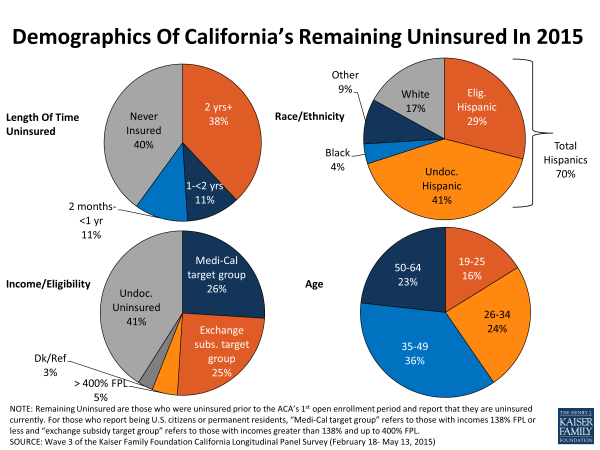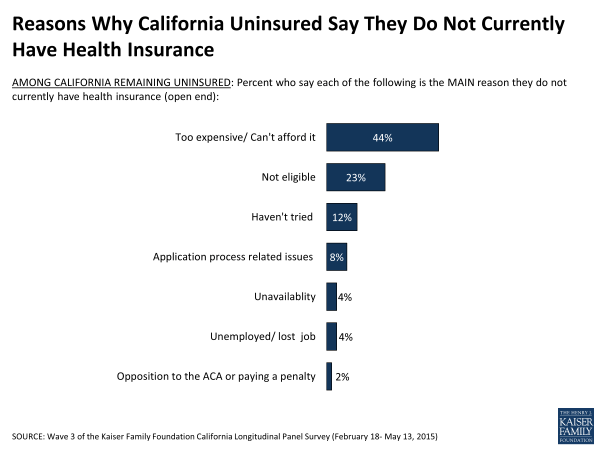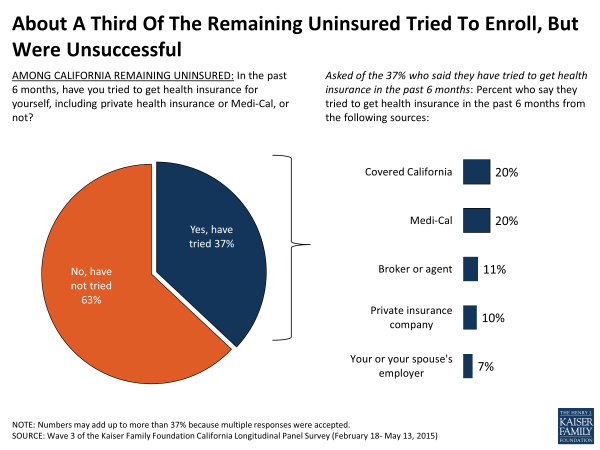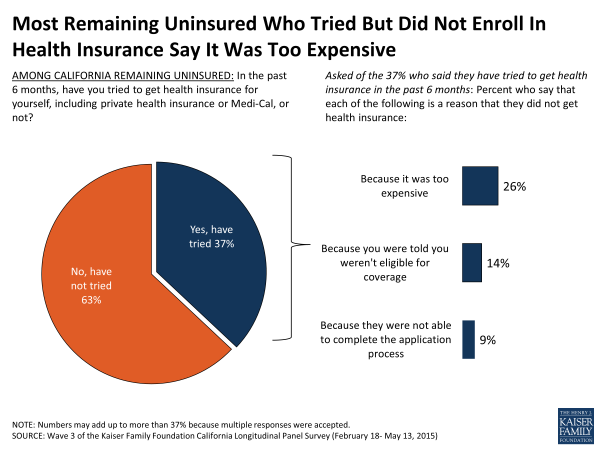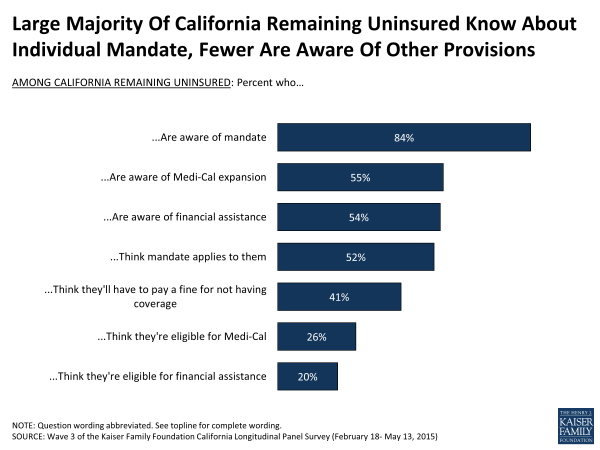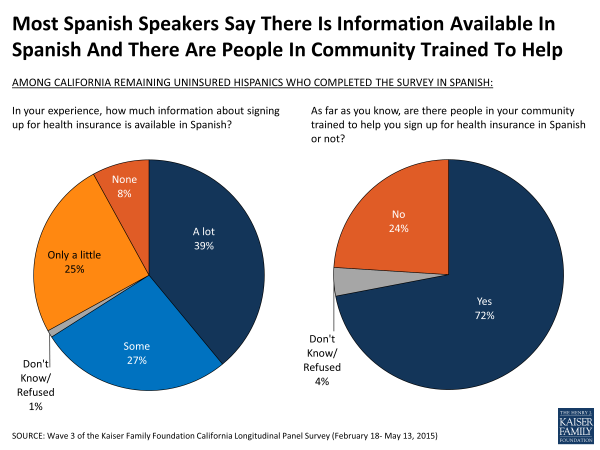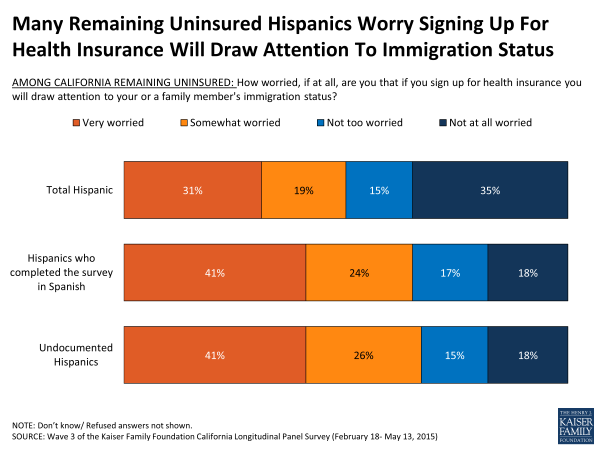California’s Previously Uninsured After The ACA’s Second Open Enrollment Period
Section 4: The Remaining Uninsured
Who Is Remaining Uninsured?
Although many previously uninsured Californians gained coverage in the nearly two years since the health care law went into effect, 32 percent report that they do not currently have health insurance. Many of these remaining uninsured had little interaction with the health insurance system in the years prior to the ACA implementation. Nearly 4 in 10 of the remaining uninsured reported in the baseline survey that they had been without health insurance for two or more years (38 percent), and an additional 4 in 10 (40 percent) said they have never had insurance. Hispanics make up 70 percent of the remaining uninsured and over half of them (41 percent) report being undocumented immigrants who are not eligible for Medi-Cal or assistance through Covered California, although state lawmakers are considering expanding eligibility to this group. Many report a family income that makes them likely eligible for Medi-Cal (26 percent) or for financial assistance through Covered California (25 percent), while 41 percent report being undocumented and therefore are ineligible.1
Why Don’t They Have Insurance?
When asked to say in their own words the main reason why they do not currently have health insurance, 44 percent of California’s remaining uninsured say it is because health insurance is too expensive and they can’t afford it. Affordability is by far the most common reason named for lacking health insurance, followed by eligibility reasons (23 percent), such as immigration concerns (15 percent) or the fact that they are ineligible for Medi-Cal or government help (7 percent). About 1 in 10 (12 percent) say they haven’t tried, they don’t need insurance, or they just haven’t gotten around to it, and fewer than 1 in 10 (8 percent) name application process related issues as the main reason. Small shares say other reasons such as unavailability (4 percent), including that their employer doesn’t offer coverage (1 percent) or their plan was cancelled (3 percent), unemployment (4 percent), and opposition to the health care law (2 percent). The shares naming these reasons for not currently having health insurance are similar to those for the remaining uninsured last spring, after the first open enrollment period.
Did They Try To Get Insurance?
Just over a third (37 percent) of California’s remaining uninsured say they tried to get health insurance in the past 6 months. Two in 10 of them (20 percent) say they attempted to get coverage from Covered California and the same share report attempting to get coverage through Medi-Cal. Fewer say they attempted to get coverage through a broker (11 percent), directly from a private insurance company (10 percent), or through an employer (7 percent).
Those who tried but did not gain health insurance point to cost as a main reason they were unsuccessful. A quarter (26 percent) of California’s remaining uninsured say they tried but didn’t get insurance because it was too expensive, including 14 percent who say they shopped for health insurance and 12 percent who say they didn’t bother shopping because they didn’t think they could afford it. Another 13 percent say they weren’t eligible for coverage, and 1 in 10 (9 percent) say they were not able to complete the application process.
Knowledge About Health Care Law Provisions That Could Benefit Them
A large share (84 percent) of the remaining uninsured in California are aware of the health care law’s requirement that most Americans have health insurance or pay a fine, and most (52 percent) think that the requirement applies to them. Although about 4 in 10 (41 percent) say they think they will have to pay a fine for not having coverage this year, 47 percent do not think they will have to pay a fine and 11 percent are unsure. It is important to note that many may in fact be exempt from the requirement due to financial hardship or other exceptions under the law. Over half (55 percent) say that if they found out they had to pay a fine for not having coverage last year in 2014 they would be likely to sign up for coverage this year.
Smaller shares of the remaining uninsured are aware of provisions of the health care law, beyond the requirement to have coverage, intended to expand coverage to the uninsured and those with lower-incomes. Just over half know that the law allowed for the expansion of the Medi-Cal program to cover more low-income Californians (55 percent) or that the law provides financial help to low- and moderate-income people to help them purchase health insurance coverage (54 percent).
California’s Remaining Uninsured Hispanics
The Hispanic population is particularly important in California because Latinos make up the largest racial or ethnic group in the state, accounting for 38 percent of the population,2 and 7 in 10 of the remaining uninsured are Hispanic (70 percent). However, 58 percent of California’s remaining uninsured Hispanics (41 percent of the remaining uninsured overall) may not be eligible for coverage because of their immigration status, which leaves 40 percent of California’s remaining uninsured Hispanics likely eligible for, but without health insurance coverage (29 percent of the remaining uninsured overall).
Navigating health insurance options and health care jargon can be confusing, and adding language differences to the equation has the potential to be an even bigger barrier to enrollment. However, Californians currently without health insurance who prefer to communicate in Spanish give largely positive feedback when asked how much information is available in Spanish and whether there are people in their community trained to help them sign up for insurance in Spanish. Most (66 percent) remaining uninsured Spanish speakers say that, in their experience, there is at least some information about signing up for insurance available in Spanish – about 4 in 10 (39 percent) say there is a lot of information available and another 27 percent say there is some information available. There is still room for improvement though, as a third of Spanish-speaking remaining uninsured Californians report that there is only a little information available in Spanish (25 percent) or say that there is none available at all (8 percent). A majority (72 percent) of Spanish-speaking uninsured also report there are people in their community trained to help them sign up, while a quarter (24 percent) say that there are not people in their community trained to help and 4 percent say they do not know.
Half of uninsured Hispanics say they are worried that if they sign up for health insurance it will draw attention to their immigration status or that of a family member, and this share is even higher among undocumented uninsured (67 percent). Additionally, slightly more than half of undocumented Hispanics (54 percent) say they worry about being deported or that a family member could face deportation if they sign up for health insurance.

